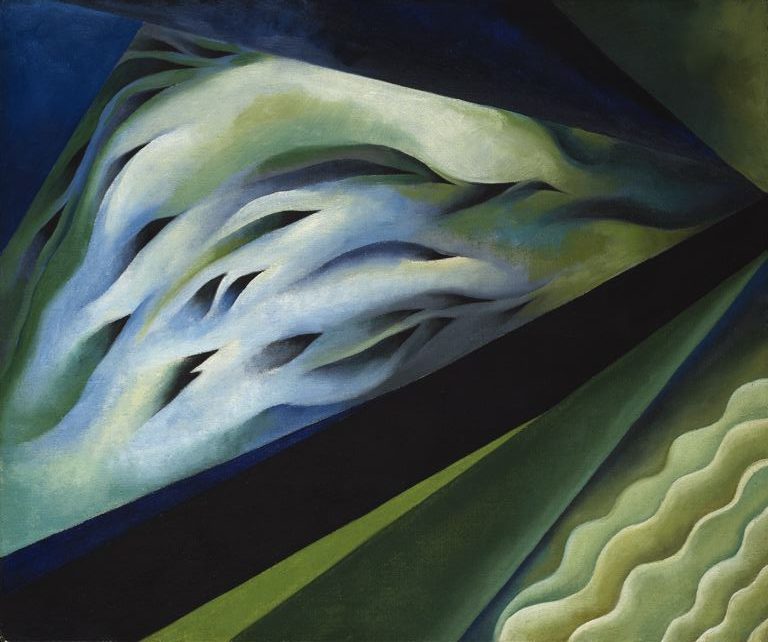Georgia O’Keeffe was inspired by the advances of Modern Art in Europe and most specifically by Wassily Kandinsky’s theories on the like between painting and music, which she explored further in Blue and Green Music. In this article, Singulart discusses Blue and Green Music in the context of O’Keeffe’s life and career.
Who was Georgia O’Keeffe?
Georgia O’Keeffe (1887-1986) was an American artist, known as the Mother of American Modernism. O’Keeffe grew up on a farm near Wisconsin and began her formal artistic training at the School of the Art Institute in Chicago in 1905. From 1908, unable to afford further education, she worked as a commercial illustrator for two years and then taught art until 1918. She continued to study in the summers between 1912 and 1918 and it was during this time that she was introduced to the work of American artist, Arthur Wesley Dow, whose style was based on creating through composition and design rather than simply recreating nature. This encounter with Dow’s work opened up a realm of alternative possibilities to the realism that O’Keeffe had previously been taught. She went on to experiment with her own personal style over the next two years, seeking to find her own personal form of expression.

In 1915, she made a series of abstract charcoal drawings, making her one of the first American artists to pursue abstraction. She then posted a selection of these abstract drawings to a friend in New York who showed them to the art dealer and photographer Alfred Stieglitz. This encounter led to her first exhibition in 1916, organized by Stieglitz. In 1918, with the financial support of Stieglitz, she moved to New York and began to work seriously as an artist. She proceeded to create her iconic abstract works, such as her Red Canna series, which O’Keeffe claimed represent her personal interpretation of flowers but which many critics interpret as abstract representations of female genitalia.
O’Keeffe and Stieglitz were married in 1924 and they remained in New York until 1929, when O’Keeffe started to spent part of the year in New Mexico, a landscape which had a profound influence on her later work. After Stieglitz’s death she moved permanently to New Mexico where she continued to paint late into her life, until illness and blindness unfortunately prevented her from doing so. O’Keeffe is internationally renowned today for her innovative art which covers a huge range of subject matter, from flowers to bones, cityscapes to landscapes, all of which are essential works of American Modernism.
Blue and Green Music: Exploring the translation of music into the visual realm

Georgia O’Keeffe painted Blue and Green Music between 1919 and 1921, when she had not yet visited Europe but had begun to learn about Modernism in her studies and most specifically in the exhibitions held at Alfred Stieglitz’s Gallery in New York. She was particularly interested and inspired by the work and theories of Wassily Kandinsky, the German Expressionist painter, who in his 1912 essay titled “Concerning art and the spiritual” discussed the link between painting and music and argued that in linking colour and music, painters could achieve a more spiritual revelation in their work.
Consequently, around 1920, O’Keeffe painted a series of works exploring “the idea that music could be translated into something for the eye”. Blue and Green Music was part of this series, in which O’Keeffe used color to evoke sound. She chose a palette of blues and greens, which vary in shade and intensity to replicate the variations of musical tones and translate them to the realm of the visual. In terms of the form, O’Keeffe continued to explore the motifs of the natural world which would come to characterize her work. In Blue and Green Music, the fluid textures of forms suggest close up, abstracted views of leaves and flowers.
O’Keeffe and the Female Form
O’Keeffe’s work was often compared by critics to the female form and described as an expression of the female nature. Although, she declared that this was not intentional and was sometimes frustrated by this label that was forced upon her, she did accept that it was an aspect that characterized her oeuvre and distinguished her from the other artists and Modernists of the time and is part of the reason she is so celebrated and her legacy is so important.
















